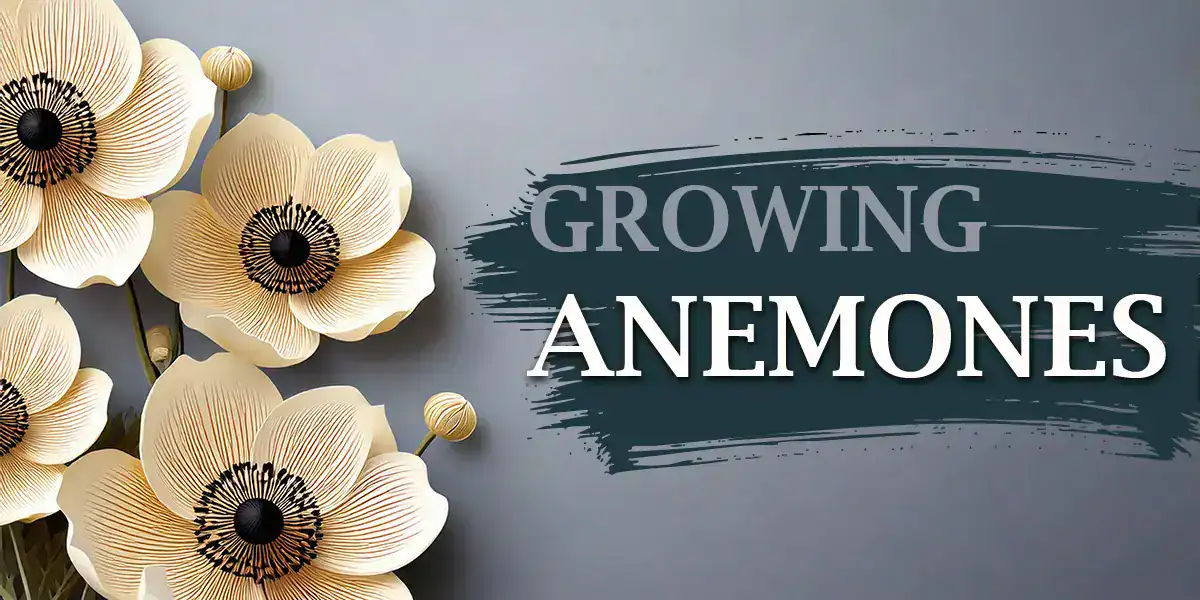The name Anemone comes from the Greek word for “windflower,” inspired by petals that flutter open in the lightest breeze.
These graceful perennials have captivated gardeners for centuries with their delicate forms and vivid colors.
They thrive in California’s mild climate. Some spread gently as ground covers, while others grow in dense upright clumps.
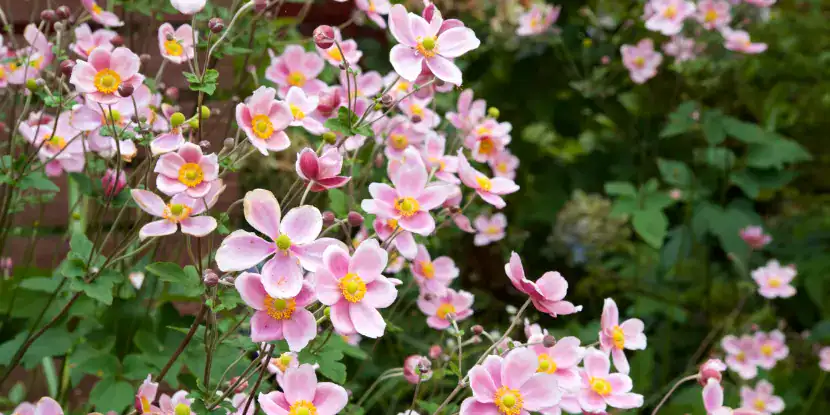
Delicate pink anemone hupehensis blossoms.
Best Varieties for California Gardens
Anemones are native across the Northern Hemisphere, from Mediterranean meadows to Asian woodlands.
They’re herbaceous perennials, meaning they die back to the ground each year (in winter or summer) and regrow from underground corms, rhizomes, or tubers. They never form woody stems like shrubs.
Spring Bloomers
- ‘De Caen’ – Single flowers in rich jewel tones, great for cutting.
- ‘St. Brigid’ – Double blooms with frilled petals and long vase life.
- Anemone blanda ‘Blue Shades’ – Compact, daisy-like flowers ideal for woodland gardens.
Late-Summer to Fall Bloomers
- ‘Honorine Jobert’ – Classic white Japanese anemone with tall, elegant stems.
- ‘September Charm’ – Soft pink flowers that glow in evening light.
- ‘Queen Charlotte’ – Vigorous grower with pale pink blooms and strong stems.
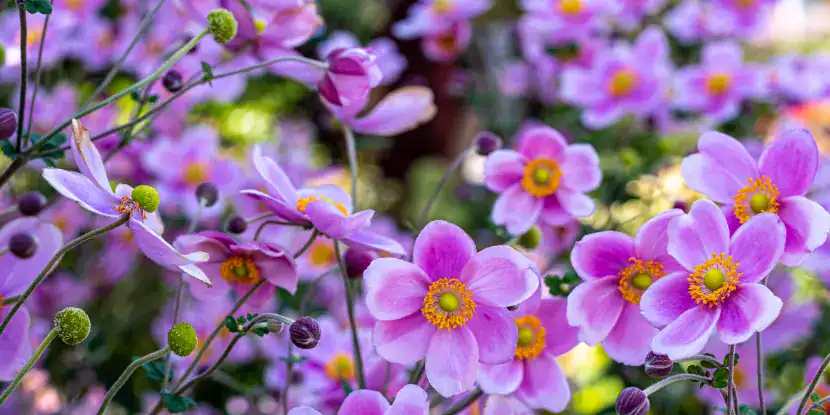
Lavender anemone hupehensis blooms in the garden.
Propagation
How you propagate depends on the type you’re growing:
- Corms and tubers (A. coronaria, A. blanda): Soak overnight in warm water before planting in fall (October–December). Plant 2–3 inches deep in well-draining soil.
- Division (A. hupehensis, hybrids): Divide clumps in fall or early spring. Replant divisions promptly and water to establish.
- Seeds: Collect ripe seeds in summer and sow immediately outdoors, or refrigerate 6–8 weeks before sowing in late winter. Germination can be slow and irregular.

Anemone tubers ready for planting.
Ideal Growing Conditions
Light
- Spring-blooming types prefer full sun to partial shade.
- Japanese varieties do best in bright shade or morning sun, especially inland, where afternoon heat can scorch leaves.
Soil
- Anemones prefer well-draining, humus-rich soil.
- They dislike soggy or compacted ground. Amend with compost or grit if needed.
- Ideal pH: 6.0–7.0.
Temperature
- Most species tolerate mild frost but not extreme heat (USDA Zones 7–10).
- Inland gardeners should mulch roots and provide afternoon shade during hot spells.
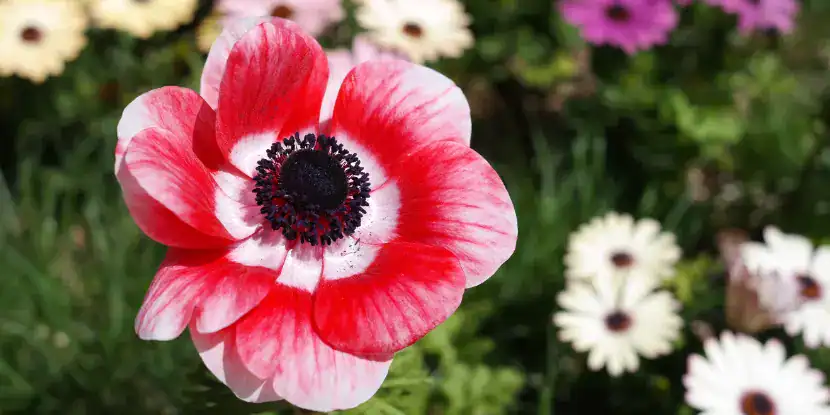
Close-up of a two-toned pink anemone blossom.
Planting & Care
- Choose a spot with morning sun or filtered light; good drainage is essential.
- Mix compost into the top 8–10 inches. Raise beds or use slopes for heavy clay soils.
- Plant corms: 2–3 inches deep, 4–6 inches apart, and divisions level with the soil surface.
- Keep soil evenly moist during active growth and bloom. Reduce watering once foliage fades.
- Apply a 2-inch layer of organic mulch to keep roots cool and retain moisture, avoiding direct contact with crowns.
Seasonal Maintenance
- After flowering: Allow leaves to die naturally to feed the next growth cycle.
- Pruning: Cut back dead stems and foliage in winter for a clean start.
- Feeding: Top-dress with compost or a balanced organic fertilizer in early spring. Avoid high-nitrogen fertilizers.
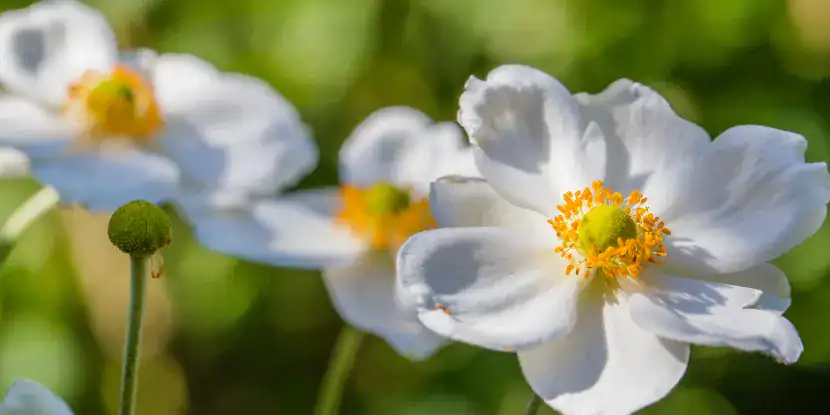
Delicate white anemone flowers swaying in the breeze.
Pests & Problems
Anemones are generally low-maintenance but may occasionally face:
- Aphids and thrips: Rinse with water or use insecticidal soap.
- Powdery mildew: Improve air circulation; avoid overhead watering.
- Crown rot: Prevent by ensuring good drainage. These plants hate wet feet.
Companion Plants
Anemones pair beautifully with other Mediterranean and woodland favorites:
- For sun: Salvia, penstemon, lavender, and iris.
- For shade: Ferns, hellebores, and hostas.
- For continuous bloom: Mix with tulips and ranunculus for a full seasonal display.

A bed of multicolored anemone flowers.
FAQs: Growing Anemones
Q: How do I plant anemone bulbs?
Plant anemone bulbs, or corms, in well-draining soil. Before planting, soak the corms in water for 2–4 hours to help them rehydrate. Plant them about 2–3 inches deep and 3–4 inches apart, with the pointed end facing downward.
Q: When is the best time to plant anemones?
Anemones thrive in cooler weather. For spring blooms, plant them in the fall. If you want blooms later in the year, you can plant them in late winter or early spring in Southern California’s mild climate.
Q: How much sunlight do anemones need?
For the best results, choose a sunny spot for varieties planted in cooler months and a lightly shaded area for warmer weather planting.
Q: How often should I water anemones?
Water anemones consistently, but avoid waterlogging. After planting, water the corms thoroughly, then maintain evenly moist soil while the plants are growing. Once established, water them about twice a week, or slightly more during dry periods.
Q: Are anemones drought-tolerant?
Anemones can handle short dry spells but prefer consistent moisture for optimal growth. They aren’t fully drought-tolerant and benefit from regular watering in Southern California’s arid conditions.
Q: What pests or diseases affect anemones?
Anemones may face challenges like aphids, powdery mildew, and crown rot. Use insecticidal soap for aphids, ensure proper air circulation to prevent mildew, and avoid overwatering to reduce the risk of crown rot.
Q: How long do anemones bloom?
Anemones can bloom for 6–8 weeks, depending on the variety and conditions. To extend the blooming season and enjoy their vibrant flowers for longer, stagger planting times and ensure proper care.
Q: Can I grow anemones in containers?
Yes, anemones grow well in containers! Use a pot with drainage holes and fill it with nutrient-rich, well-draining soil. Group several corms together in a single container for a lush, colorful display.

